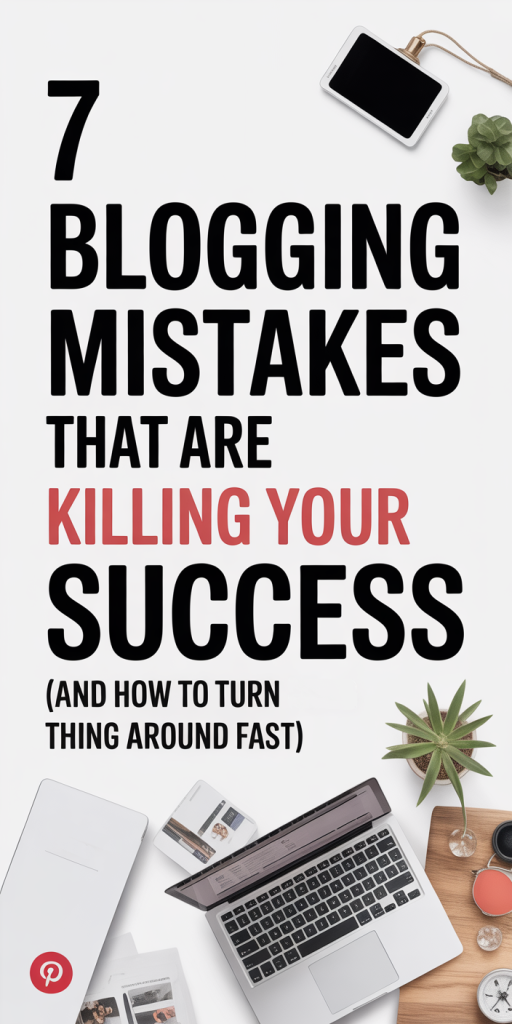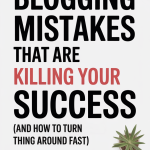Hey there, fellow content creator! So you’ve decided to jump into the blogging world, huh? First off, high five for taking that leap! Starting a blog is exciting, but let’s be real—it can also feel like you’re trying to build a rocket ship with nothing but duct tape and enthusiasm.
I get it. When I launched my first blog, I was clueless but determined. And boy, did I make some epic mistakes along the way! The good news? You don’t have to repeat my blunders.
In this post, I’m sharing the six most common blogging mistakes I see creators make time and again (including ones I’ve made myself). More importantly, I’ll show you exactly how to fix them so you can save yourself tons of headaches, wasted time, and yes—money too.
Whether you’re just thinking about starting a blog or you’ve been at it for a while, these tips will help you avoid the pitfalls that trip up so many bloggers. Let’s dive in and get your blog on the right track!
Blogging Mistakes That Cost You Big Time
When you’re pouring your heart and soul into your blog, the last thing you want is to sabotage your own success. Yet that’s exactly what happens when you fall into these common traps.
Mistake #1: Flying Without a Flight Plan
Imagine setting off on a road trip without a map, destination, or any idea of what you want to see along the way. Sounds chaotic, right? That’s exactly what blogging without a strategy feels like.
Here’s the deal: if you don’t know where you’re going with your blog, how will you ever know if you’ve arrived? Without clear goals, you’re just throwing content into the void and hoping something sticks.
I spent my first six months blogging about whatever popped into my head that day. The result? A confusing mess of posts that didn’t connect with any specific audience. My traffic was dismal, and I couldn’t figure out why no one was sticking around.
How to Fix It:
Start by asking yourself these four crucial questions:
1.Why am I blogging in the first place? (Is it to share expertise, make money, build a community?)
2.Who exactly am I trying to reach? (Get specific about your ideal reader)
3.What unique value can I offer that they can’t easily find elsewhere?
4.Where do I want my blog to be in 6 months? A year? Two years?
Once you have those answers, break your goals down into manageable chunks. I like to divide my year into quarters, with each quarter having a primary focus:
First Quarter: Research and planning. This is when I dig deep into what my audience wants and create a content calendar for the coming months.
Second Quarter: Content creation mode. I focus on producing high-quality, valuable posts that address my readers’ biggest questions and challenges.
Third Quarter: Promotion and outreach. With a solid base of content, I shift to getting my blog in front of more eyes through social media, guest posting, and other marketing tactics.
Fourth Quarter: Monetization strategies. Now that I have traffic and engagement, I can thoughtfully introduce ways to earn from my blog without compromising quality.
This approach gives you direction while still allowing flexibility. Trust me, having even a basic roadmap will make your blogging journey so much smoother!
Mistake #2: The Disappearing Act
We’ve all been there—you start a blog with tons of enthusiasm, publishing three posts a week. Then life happens. Suddenly, it’s been two months since your last update, and your once-promising blog is collecting digital dust.
Inconsistency is the silent killer of blogs. When readers can’t count on you showing up, they stop coming back. And search engines? They love fresh content and regular updates.
How to Fix It:
The secret to consistency isn’t superhuman discipline—it’s smart planning. Here’s what works:
1.Be realistic about your schedule. It’s better to consistently publish one great post every two weeks than to aim for three weekly posts and burn out.
2.Create a content calendar that plans at least 3 months ahead. When you know what you’re writing next, you avoid the dreaded “blank page syndrome.”
3.Batch similar tasks together. Spend one day researching several posts, another day writing, and another editing. This workflow is much more efficient than starting from scratch each time.
4.Build a small content buffer—having 2-3 posts ready to go gives you breathing room when life gets hectic.
Remember, consistency doesn’t mean frequency. It means reliability. Your readers should know when to expect new content from you, whether that’s weekly, bi-weekly, or monthly.
Mistake #3: The Echo Chamber Effect
When I first started blogging, I thought I needed to sound “professional” and “authoritative.” The result? My posts read like boring textbooks, and my personality was nowhere to be found.
Too many bloggers fall into this trap—they mimic other successful blogs instead of developing their own voice. But here’s the truth: in a sea of similar content, your unique perspective is your superpower.
How to Fix It:
1.Write like you talk. Record yourself explaining your topic to a friend, then transcribe it. Notice how your natural voice sounds—that’s the voice your blog should have.
2.Share personal stories and experiences. Readers connect with real people, not faceless information sources.
3.Have opinions! Don’t be afraid to take a stand on topics in your niche. Thoughtful, well-supported opinions make your content memorable.
4.Ask yourself: “If someone removed my name from this post, would my regular readers still recognize it as mine?” If not, you need to inject more of your personality.
Your voice might not appeal to everyone—and that’s perfectly okay. The readers who do connect with your authentic style will become your most loyal fans.
Mistake #4: SEO Blindness
I spent my first year blogging completely ignoring SEO. I figured if my content was good enough, people would find it. Spoiler alert: they didn’t.
On the flip side, some bloggers go too far in the other direction, stuffing keywords everywhere and writing for search engines instead of humans.
Both approaches are mistakes. Without basic SEO, even brilliant content gets buried. But when you prioritize SEO over reader experience, your content feels robotic and unengaging.
How to Fix It:
Find the sweet spot with these balanced approaches:
1.Do keyword research before writing, but choose topics you genuinely care about. Tools like Google’s Keyword Planner or even just the Google search bar’s autocomplete can show you what people are looking for.
2.Focus on long-tail keywords (specific phrases like “how to grow tomatoes in apartment balconies”) rather than competitive broad terms (“gardening tips”).
3.Use your keywords naturally in your title, headings, and throughout your content—but only where they make sense.
4.Remember that the best SEO strategy is creating content so helpful that people want to share it and link to it.
Think of SEO as helping your ideal readers find the valuable content you’ve created for them, not as a trick to game the system.
Mistake #5: The Lone Wolf Syndrome
Blogging can feel isolating. You sit at your computer, pour your thoughts onto the screen, and sometimes wonder if anyone is actually reading.
Many bloggers make the mistake of working in isolation, never reaching out to others in their niche or engaging with their readers. This limits your growth and can lead to burnout.
How to Fix It:
1.Connect with other bloggers in your niche. Comment thoughtfully on their posts, share their content, and reach out for potential collaborations.
2.Join blogging communities and forums where you can ask questions, share experiences, and find support.
3.Actively engage with your readers—respond to comments, ask for feedback, and create content that addresses their specific questions.
4.Consider finding a blogging buddy or accountability partner who understands your challenges and can provide motivation when you’re struggling.
Remember, successful blogging isn’t just about creating content—it’s about building relationships. The connections you make can lead to guest posting opportunities, backlinks, collaborations, and friendships that make the blogging journey more rewarding.
Mistake #6: Perfectionism Paralysis
This was my biggest blogging hurdle, and I see it trip up countless others too. You spend hours crafting the “perfect” post, tweaking every sentence, second-guessing every point, and ultimately… never hitting publish.
Perfectionism keeps good content locked away where it can’t help anyone. It’s the enemy of progress and growth.
How to Fix It:
1.Embrace the mantra “done is better than perfect.” A published B+ post helps your readers more than an unpublished A+ post that never sees the light of day.
2.Set firm deadlines for yourself and stick to them, even when you feel your work could be better.
3.Remember that blogs are living documents—you can always update and improve posts after publishing them.
4.Start with a structured outline before writing. This helps prevent endless rewrites since you’ve already mapped out your main points.
5.Limit your editing rounds. Give yourself permission to review a post 2-3 times, then publish it and move on.
The truth is, your early posts probably won’t be your best work—and that’s okay! Every published post teaches you something and improves your skills for the next one.
Mistake #7: Neglecting the Mobile Experience
Here’s a mistake that wasn’t in the original list but is absolutely critical in today’s digital landscape: ignoring how your blog looks and functions on mobile devices.
Over 50% of web traffic now comes from mobile phones, yet many bloggers still design and test their content exclusively on desktop computers. This creates a frustrating experience for the majority of your potential readers.
How to Fix It:
1.Choose a responsive theme that automatically adjusts to different screen sizes.
2.Regularly test your blog on your own smartphone and tablet to see what readers experience.
3.Use shorter paragraphs and plenty of white space—long text blocks are especially difficult to read on small screens.
4.Make sure your font size is large enough to read comfortably on mobile without zooming.
5.Test your site’s loading speed on mobile devices—slow-loading pages drive readers away quickly.
6.Ensure that clickable elements (like buttons and links) are large enough to tap accurately with a finger.
Taking the time to optimize for mobile doesn’t just improve user experience—it also positively impacts your search engine rankings, as Google now uses mobile-first indexing.
Final Thoughts: How To Avoid Blogging Mistakes
Here’s something I wish someone had told me when I started: blogging is a marathon, not a sprint. The most successful bloggers aren’t necessarily the most talented writers or the most tech-savvy individuals—they’re the ones who keep showing up, learning from their mistakes, and consistently improving.
Every blogger makes mistakes. What separates the successful ones is their willingness to recognize those mistakes, adjust course, and keep moving forward.
So if you’ve recognized yourself in any of these mistakes, don’t beat yourself up! Instead, celebrate that you’re now aware of the issue and have practical steps to fix it. Your blog will grow stronger because of the lessons you learn along the way.
What blogging mistakes have you made, and how did you overcome them? I’d love to hear your experiences in the comments below!
Happy blogging!






